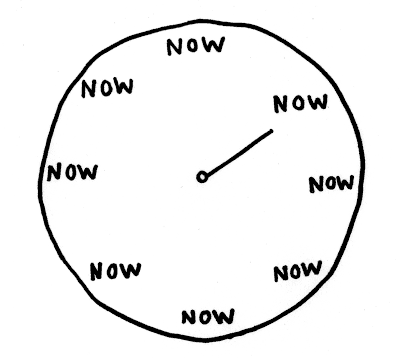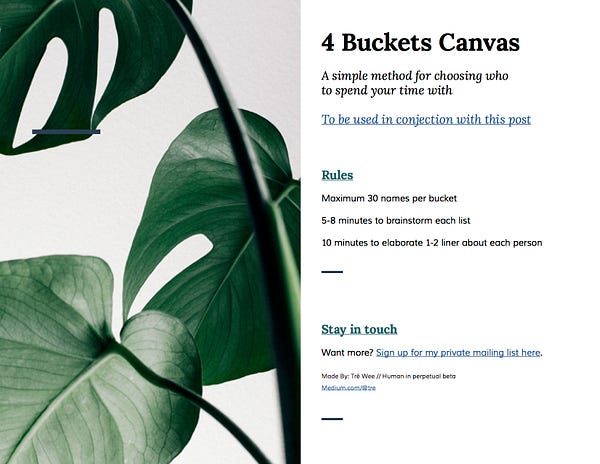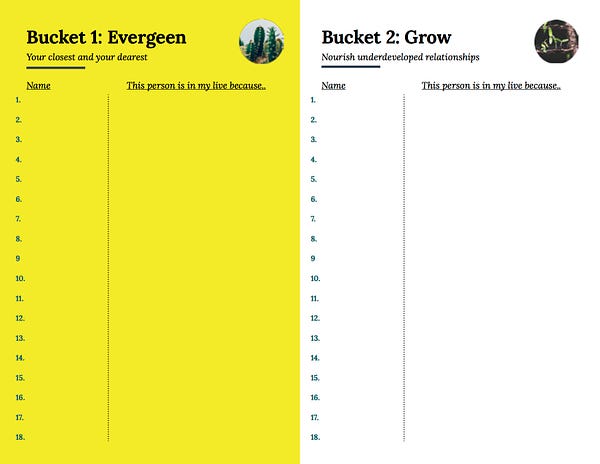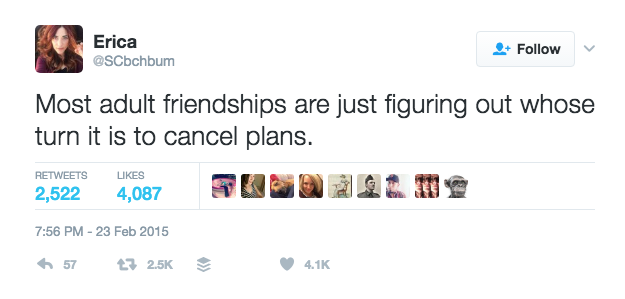How to Choose Who to Spend Your Time With
How to Choose Who To Spend Your Time With orginally appeared on The Mission.
After years of unfulfilling work, Bronnie Ware was searching for something more meaningful. Despite having no prior experience, Bronnie found herself stumbling into palliative care, where she spent several years caring for patients in the last twelve weeks of their lives.
During this time, as the patients revealed their dying epiphanies to her in their raw and honest conversations about life and death, Bronnie came to notice that a few themes kept surfacing repeatedly, which she eventually published in this now widely shared blog post.
“Death offers mankind a full view of truth.” — Socrates
Top 5 Regrets Of The Dying
1. I wish I’d had the courage to live a life true to myself, not the life others expected of me.
2. I wish I hadn’t worked so hard.
3. I wish I’d had the courage to express my feelings.
4. I wish I had stayed in touch with my friends.
5. I wish that I had let myself be happier.
I suppose the post resonated with so many people because it hits you right in the gut. I bet you feel guilty for at least a couple of them. I know I do. Regrets are funny business. Nobody likes them yet everybody has them. We want to avoid having regrets but we also don’t necessarily want a life devoid of regrets entirely, because it would mean that we didn’t try and fail.
But let’s hold on to that guilt and let us try to use it productively. Looking at the list, wouldn’t you agree the five regrets could be further categorised under these two themes:
1. How they would choose to spend their time and energy differently if they were given a second chance.
2. They are all about relationships; the ones we have with people and the one we have with ourselves.

Therefore, it seems that if we wish to avoid having those regrets in the future, then we must learn to choose more wisely now how we spend our time and who to spend it with.
Regret /rɪˈɡrɛt/ — a feeling of sadness about something sad or wrong or about a mistake that you have made, and a wish that it could have been different and better.
This is where the 4 Buckets come in.
The 4 Buckets Method
is a simple exercise that helps you to get a clear overview of the relationships in your life and a better understanding on why they exist. By doing it, you’ll get a better sense of where your time is going and how to prioritize which relationships to focus on, and equally important, which ones to put on the back burner.
“Tell me with whom you consort and I will tell you who you are; if I know how you spend your time, then I know what might become of you.” ― Johann Wolfgang von Goethe
How it works:
1. Create 4 lists of names across 4 different relationship categories.
2. Fill those list with names (15–30) and elaborate in 1–2 lines why this person exists in your life.
3. Estimate the time and energy you currently spend in each list, and decide what’s the ideal balance.
* I've prepared a downloaded worksheet for you at the end of this post.


Why is it called the 4 buckets?
Because relationships are like gardening; you reap what you sow. To be a good gardener you need to make sure that the soil is healthy and the conditions are right for life to flourish, to select the right plants to nurture, to ensure that new seedlings are planted and the weeds are plucked consistently.
You need an overview of how much land you have to work with, how fertile the soil is accordingly to the year, what fertilizers to use, when to water, what types of plants you have in your garden, and the type of care they need to flourish. You do this so that you better understand how to allocate your time and energy to enjoy the fruits of your labor.
Bucket 1 — Evergreen 🌵
This is the bucket where your closest and dearest should go into. They are the most meaningful and enriching relationships in your life, however you define that. Together, the people here form the core of your social circle. They are the people who you can expect to lean on in hard times, and hopefully, people whom you’d do the same for in return.
Evergreen relationships, like evergreen trees, maintain their foliage and cover throughout the year, and can reduce chilling winds in the winter and provide shade in the summer. Evergreen relationships are deep and lasting, defensible and weatherproof, and this is an bucket that you should be investing the bulk of your time and effort.
Bucket 2 — Grow 🌿
This bucket serves to grow under developed relationships, both existing and new. Ideally, in every relationship the give-and-take ratio is somewhat balanced. In reality, however, there is usually an imbalance at any given time or phase; there’ll be a party who is giving more, and sometimes that person who needs to step up is you.
Those that go into this bucket could be people who you are interested in developing a deeper relationship with, or it can also be people whom you have neglected and would like to repair and restore your relationships with them. By hanging onto deadweight or relationships that are underserved, you are doing both yourself and the other person a disservice.
Bucket 3 — Plant 🌱
This is the bucket where you seed new relationships. These are people whom you think might have potential to blossom into something meaningful. Maybe it’s the cute guy/girl you met at the party, or the new colleague at your at your new job.
Interestingly, this is the bucket where it can deliver the biggest payoff. Since you’re in exploration mode here, the chances of surprises are inherently built-in. For example, some of my closest friends and collaborators in recent years have seemingly popped out of nowhere, serendipitously. Spending time in this bucket, even though not always comfortable, can be hugely rewarding.
Bucket 4 — Prune ✂️
This is a highly important bucket. It’s where you give yourself permission to let go of relationships, or to free yourself yourself from negative ones that are pulling you back. By frequently removing negative and stale relationships, you keep your social circle fresh and vibrant, and are able to create new opportunities for new ones to develop, by redirecting time and energy into the first three buckets, the ones that deserve it.
Why prune and how to choose which relationships to prune.
Life is too short to constantly invest in relationships that don’t make us happy. Identifying these relationships is the first step in liberating yourself from them.
“A friend to all is a friend to none.” — Aristotle.
3 criteria I use for pruning relationships
I use a rule of three for every relationship: I will invest in taking three initiatives on my part to explore the relationship. If nothing comes out of those exploration efforts or if I’m disappointed thrice then this is a rule for giving myself permission to de-prioritize those relationships so I can focus on those that matters.
1. Flaky, unresponsive, no initiated effort. These are the people whom you feel are not / have not been giving back to the relationship. Maybe they are flaky, maybe they are unresponsive, or maybe they are just in general not taking an active role in developing your relationship.
2. Toxic and negative. These are the people I find draining to be around. Maybe they’re always complaining, maybe they’re always hating, maybe they are transactional and manipulative. It depends on how you define toxic and negative.
3. A lack of space, energy, or desire from your part. We need to stop saying “Let’s meet up sometime!” if we don’t have intention of actually following through. These “open-commitment loops” are insidiously draining. Imagine running multiple tabs simultaneously on your Internet browser. Individually, these tabs may not seem like much but cumulatively, they really add up have a huge impact on your processing power.

If you’re not burning for it, don’t do it. Read this excellent piece by @Derek Sivers: HELL Yeah Or No
How The 4 Buckets Can Help You
Some of us are better in building long term relationships, some at keeping in touch and maintaining relationships, and the rest of us at meeting at new people. Whatever your strengths and weaknesses are, you probably already have a good sense of it. What the 4 Buckets help you to do is to see more clearly how you might negotiate a more sustainable balance between them.
For example, most people I know (including myself) find it easier to hang out with familiar faces (Bucket 1) than to be out there meeting new people consistently (Bucket 3). As tempting as it is to only do the things that we love and which come most naturally and easily to us, a full life is a varied and diverse one and not some narrow experience of a single element.
Our Need For Consistency
Just like our in-built sense of fairness and the need to be connected with others, psychologists say that it’s a human characteristic that we are driven to be consistent in all areas of life; our attitudes, values, habits, and promises. We want to be consistent ourselves and we want others to be consistent. It’s an essential fundamental quality to cultivate across all aspects of our life.
If you think about it, what are regrets if not the accumulation of missed opportunities; where we consistently failed to do what we really should have done. Regrets such as “I wish that I had let myself be happier” is not so much as being happy once or a few times, but more about being happier consistently over the course of their lives.
This dovetails perfectly with one of my biggest insights in the last few years: I feel happiest and most at peace when I’m focusing my time and energy on what truly matters to me. In other words, I feel best when what I do is consistent with what I believe.
Choose Well To Live Well
Imagine a reality with less guilt and regret because you’re secured in the comfort that your actions are aligned with your most deeply cherished values and beliefs.
A reality where you strike a better balance between exploring new relationships and enjoying the familiar ones, where you no longer worry about somewhere else you could be or someone better to be with, because you know you are exactly where you need to be. A reality where you experience tranquility and happiness more consistently.
Doesn’t that sound nice? And to think, all you have to do is to begin by imagining your friends as plants and then compulsively ordering them into lists :D
Interested in doing this for yourself? Use this worksheet.
Shine is supported by members like you. When you buy through links on our site, we may earn an affiliate commission. See our affiliate disclosure for more info.

